End of July, Early August
For the last few days of July, and the first few days of August the Southern Residents made fleeting appearances in the Salish Sea, and now it appears they are at it again. I was beginning to rely on the constant comfort I had knowing that the whales could pass the lighthouse at any time…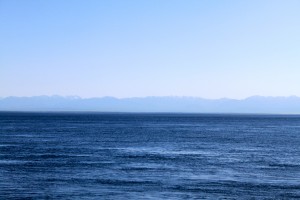 It makes everything during the day so much more exciting when there is the prospect of whales. One good thing that has come from the whales’ drawn out absence is that I have been able to re-focus my appreciation on the beauty that is San Juan Island.Today I have directed my focus to the ever-majestic Olympic Mountains. The sun is shining down on the snowy peaks that tower above the Strait of Juan de Fuca’s blue-green waters. The view in front of me is something most seen on the front of postcards, and although there may not be orca whales in my midst, I am constantly surrounded be the natural beauty of the Salish Sea and the San Juan Archipelago.
It makes everything during the day so much more exciting when there is the prospect of whales. One good thing that has come from the whales’ drawn out absence is that I have been able to re-focus my appreciation on the beauty that is San Juan Island.Today I have directed my focus to the ever-majestic Olympic Mountains. The sun is shining down on the snowy peaks that tower above the Strait of Juan de Fuca’s blue-green waters. The view in front of me is something most seen on the front of postcards, and although there may not be orca whales in my midst, I am constantly surrounded be the natural beauty of the Salish Sea and the San Juan Archipelago.
Read More
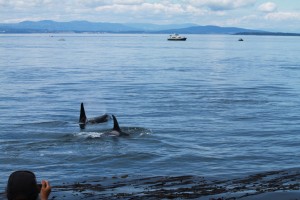
Reflecting on July…
Often when orca whales pass Lime Kiln Lighthouse they are just cruising by, traveling either north or south, most likely in search of Chinook salmon. No matter how often these “passbys†occur, they are always exciting, especially if you have been waiting for the whales to swim your way all day. But every now and then there are the special occasions, that have all the qualities of a dream, when one or two, sometimes even 20, orca whales glide through the kelp beds just beyond one’s reach…These moments, even after being in the presence of orcas for almost 4 months, never fail to lose their eerie luster…My first “close†encounter with the Southern Resident Orcas was earlier this summer. L Pod had finally returned to the Salish Sea, and I was especially eager to have an encounter with their newest member, L113.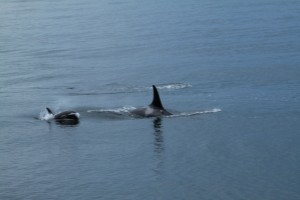  Almost all 40 members passed the lighthouse, but about 5 came around the corner out of Deadman’s Cove unbelievably close to the shoreline. L41, Mega and two other females along with L113 and mom L….. It took my breath away to see them so close. It seemed as if I could reach out and almost touch them. The animals crisscrossed back and forth in the water, and the new calf lunged through the water in the middle of all of them. As they passed the lighthouse they veered into Lime Kiln Bay. At first it appeared that they were only frolicking in the kelp beds, but a few tail slaps, one breach, and a spy hop later, I was getting the inkling that this was no ordinary play session. After watching the group of whales behavior for at least 20 minutes I started to think that I was actually witnessing a lesson on foraging, catching Chinook 101 if you will? Whether or not this was actually what the whales were up to, it was an amazing encounter. And still is one of my favorites of the summer.
 Almost all 40 members passed the lighthouse, but about 5 came around the corner out of Deadman’s Cove unbelievably close to the shoreline. L41, Mega and two other females along with L113 and mom L….. It took my breath away to see them so close. It seemed as if I could reach out and almost touch them. The animals crisscrossed back and forth in the water, and the new calf lunged through the water in the middle of all of them. As they passed the lighthouse they veered into Lime Kiln Bay. At first it appeared that they were only frolicking in the kelp beds, but a few tail slaps, one breach, and a spy hop later, I was getting the inkling that this was no ordinary play session. After watching the group of whales behavior for at least 20 minutes I started to think that I was actually witnessing a lesson on foraging, catching Chinook 101 if you will? Whether or not this was actually what the whales were up to, it was an amazing encounter. And still is one of my favorites of the summer.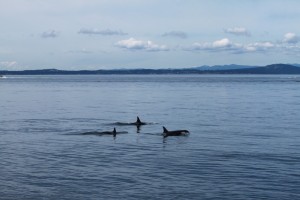
Read More
June 2012
The other day I was lucky enough to see some members of the Southern Resident Killer Whale community in what appeared to be a feeding frenzy. A report came in that the whales were swimming north towards the lighthouse. As I went out to find my usual seat on the rocky shoreline, clipboard, camera, and binoculars all in tow, I filled with anticipation…
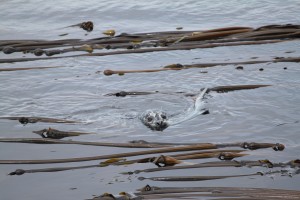 Before I knew it the whales were surfacing just off shore… The calming “swoosh†of their blowholes filled my ears. It was members of J Pod! A few of the whales blew past the lighthouse, but some select whales stuck around and took up milling. After a few minutes of behavior observations, I noticed a silver streak breaking the surface of the water out of the corner of my eye. I pulled out my camera, sensing that whatever the streak was would reappear. Sure enough it did, but this time it was in the mouth of a harbor seal! The seal, cleverly tucked into the kelp beds, stuck its head out of the water to proudly show off its latest catch, a huge Chinook salmon!
Before I knew it the whales were surfacing just off shore… The calming “swoosh†of their blowholes filled my ears. It was members of J Pod! A few of the whales blew past the lighthouse, but some select whales stuck around and took up milling. After a few minutes of behavior observations, I noticed a silver streak breaking the surface of the water out of the corner of my eye. I pulled out my camera, sensing that whatever the streak was would reappear. Sure enough it did, but this time it was in the mouth of a harbor seal! The seal, cleverly tucked into the kelp beds, stuck its head out of the water to proudly show off its latest catch, a huge Chinook salmon!
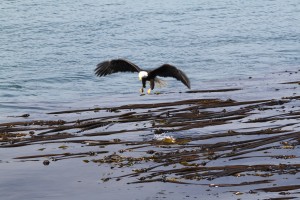 At first I wasn’t positive that the salmon was a Chinook, until I got a glimpse of the big, black mouth that Chinook salmon are notorious for. I took picture after picture, and dive after dive, the seal would reappear in the same spot showing off less and less of its devoured meal each time. Just when all that was left of the Chinook was pink flesh and the seal’s pride was at its peak, a bald eagle swooped in for the steal… Luckily the seal was fast and dove down right as the eagle was readying its talons. The scene reminded me of something that would be featured in an episode of Planet Earth. I felt very lucky to be able to witness such a wild interaction between three animals that frequent Lime Kiln Lighthouse in the summer months. What a good reminder of how all organisms in the Salish Sea are connected, and that most all of them, in some way, depend on the salmon runs just as the Southern Resident Killer Whales do.
At first I wasn’t positive that the salmon was a Chinook, until I got a glimpse of the big, black mouth that Chinook salmon are notorious for. I took picture after picture, and dive after dive, the seal would reappear in the same spot showing off less and less of its devoured meal each time. Just when all that was left of the Chinook was pink flesh and the seal’s pride was at its peak, a bald eagle swooped in for the steal… Luckily the seal was fast and dove down right as the eagle was readying its talons. The scene reminded me of something that would be featured in an episode of Planet Earth. I felt very lucky to be able to witness such a wild interaction between three animals that frequent Lime Kiln Lighthouse in the summer months. What a good reminder of how all organisms in the Salish Sea are connected, and that most all of them, in some way, depend on the salmon runs just as the Southern Resident Killer Whales do.
When I looked back to the whales, I was happy to see they were continuing their behavior pattern, which one could guess by the presence of Chinook was foraging! It always gives me a good feeling to know that the whales are finding food, especially since limited availability of prey is such a threat to their recovery.
I can’t wait to have more incredible encounters like this one my summer on San Juan Island continues!
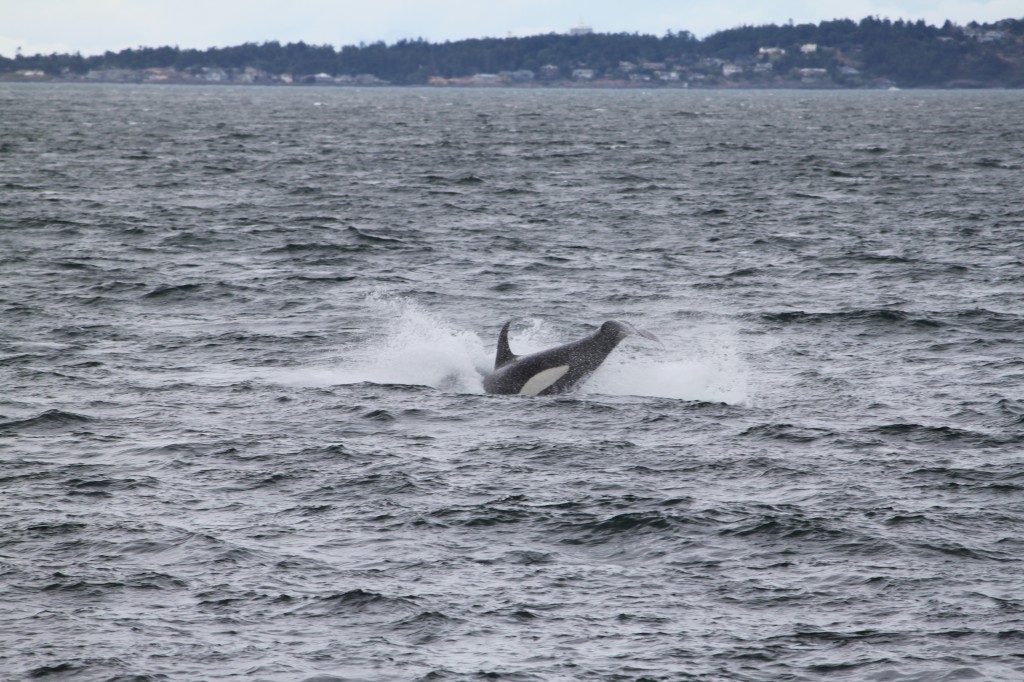
Read More
June  2012
Before I knew it summer was finally upon me, and that meant that my long awaited (2 weeks at most) return to Lime Kiln Lighthouse was not even a day away…

Lime Kiln Lighthouse has always held a magical charm for me. At first I admired the lighthouse from afar, back in my small hometown in Minnesota. I would look at pictures of this amazing, far off place and imagine what it would be like to see the tall, sleek, black dorsal fin of J1 cutting through the kelp beds just off the rocky shoreline. When I finally arrived at the lighthouse this past March for the Beam Reach course, it still felt as if it was a mythical place to me. But now, now that I have been in the San Juan Islands for over 10 weeks, the lighthouse feels like one of the only things that is still familiar to me now that the Beam Reach course is over. The thing that I looked forward too the most about my return was seeing the orcas again. I couldn’t wait to have my first solo encounter with the whales at Lime Kiln, to me it seemed that once this happened, my summer would truly begin. Lucky for me, the Southern Residents were extremely cooperative and passed the Light my first day back!
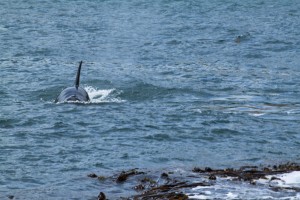 Members of J Pod swam passed the lighthouse within hours of my arrival. To me, it felt as if everything was just beginning, it was the start of a completely new chapter. Of course for J2 Granny, J8 Speiden, and the other members of J Pod it probably was just the usual passing in their West Side Route. Needless to say this encounter with the whales gave me inspiration, and I began to “set my sights†on the goals for summer time.
Members of J Pod swam passed the lighthouse within hours of my arrival. To me, it felt as if everything was just beginning, it was the start of a completely new chapter. Of course for J2 Granny, J8 Speiden, and the other members of J Pod it probably was just the usual passing in their West Side Route. Needless to say this encounter with the whales gave me inspiration, and I began to “set my sights†on the goals for summer time.
This summer I plan to study the Southern Resident Killer Whales as they pass Lime Kiln Lighthouse and observe their surface behaviors as well as their acoustic communications. I will also be monitoring underwater noise levels in the SRKW environment and looking for significant changes in their vocalizations.
For a better idea of what I am listening too, check out the Orcasound Hydrophone Network at www.orcasound.net. Here you can listen the live streaming hydrophones at Lime Kiln and other various locations in the Salish Sea, check out the observations of other listeners, and log your own findings as well! Any and all observations that come from fellow listeners are helpful and exciting!
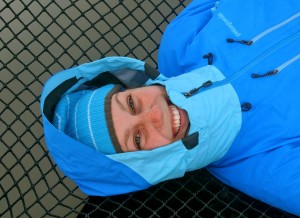 About the Blogger:Â Breanna Walker is a Beam Reach Spring 2012 Alumnus. Her project this past quarter focused on the potential effects that shipping traffic might have on Southern Resident Killer Whale echolocation. After such an amazing experience during the Beam Reach course and time in the San Juan Islands this spring, Breanna decided to prolong her stay for the entire summer. Collaborating with Scott Veirs and others in the SRKW Research Community, Breanna will be acting as the Beam Reach Intern, conducting more SRKW Acoustic research at Lime Kiln Lighthouse. Breanna is also working with The Whale Museum this summer as a naturalist, conducting educational outreach both at Lime Kiln Lighthouse and aboard the Washington State Ferries. Breanna has a passion for the Southern Resident Killer Whales and the Salish Sea ecosystem. The only thing she enjoys more than watching the orcas is talking to others about them.Â
About the Blogger:Â Breanna Walker is a Beam Reach Spring 2012 Alumnus. Her project this past quarter focused on the potential effects that shipping traffic might have on Southern Resident Killer Whale echolocation. After such an amazing experience during the Beam Reach course and time in the San Juan Islands this spring, Breanna decided to prolong her stay for the entire summer. Collaborating with Scott Veirs and others in the SRKW Research Community, Breanna will be acting as the Beam Reach Intern, conducting more SRKW Acoustic research at Lime Kiln Lighthouse. Breanna is also working with The Whale Museum this summer as a naturalist, conducting educational outreach both at Lime Kiln Lighthouse and aboard the Washington State Ferries. Breanna has a passion for the Southern Resident Killer Whales and the Salish Sea ecosystem. The only thing she enjoys more than watching the orcas is talking to others about them.Â
Read More
We did it! Beam Reach Class 121 survived almost four full weeks living aboard a catamaran, studying physical oceanography, underwater sounds, and the Southern Resident Killer Whales, and most importantly we did it together.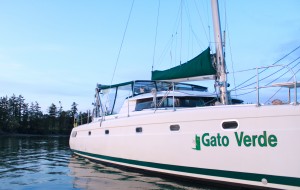
Our experience wasn’t just any regular research field experience. We were lucky enough to live aboard the Gato Verde, a glorious 42’ catamaran developed to be “Boat Greenâ€. Not only was our living experience pretty plush for field researchers, but we also learned how to live sustainably on the water while conducting our own individual research projects.
Although designing and conducting my own research project was academically challenging, living and working on the Gato proved to be a whole different kind of challenge. I learned to be very conscious of my own space and personal needs in a group dynamic, which I feel is one of the most valuable lessons I learned aboard the Gato. I also became very conscious of other things during our time at sea: my waste output as well as my classmate waste output; the state of the currents and tides at any given moment, our time on the water each and every day, and where all the good mooring spots are near Haro Strait. We monitored these various factors as well as other important boat factors every day before we planned our science activities during the daily morning meetings.
Monitoring Our Impacts
Each day we were assigned different duties in terms of boat maintenance and preparation for the day ahead. The student assigned to “systems†each day was required to monitor the battery and biodiesel usage of the Gato as well as our water and sewage levels. These four things are all very important to keep track of to keep the Gato running efficiently and also to be aware of our environmental impact. Sewage, also known as “black water†is a huge environmental concern for oceanic boaters. We monitor our sewage levels daily to ensure that we never run out of room in our holding tank. Anaerobic bacteria dominate our black water system and it is vital to make sure we do not run into a scenario where we dump this black water into the oceanic environment.
Part of living and, pooping, aboard a boat also means that you have to get all of the poop off of the boat, unless you want it to continue living with you, which wouldn’t be a pleasant experience for anyone. We were lucky enough to be able to “pump out†our sewage system three different times! When pumping out we usually had two students helping. A big hose with a suction cup at the end of it was attached to our sewage tank and then magic happens! Our waste, which now looks like brown, muddy water, begins to pump through this hose off of our boat. Although it sounds somewhat repulsive, it is actually kind of interesting. To make it easier on the students who were pumping out each time, we all took turns purchasing ice cream to share at the convenience store. Turns out that a little bit of ice cream made pumping out a favorite activity of Beam Reach class 121!
To decrease our sewage output aboard the Gato, we attempted to use “shore headsâ€, or toilets on land, whenever they were available. This meant if we pulled up to a mooring site and there was dock space available, we always went for the dock space, just because we could use the shore heads instead of the heads aboard the Gato, which means more time between pump outs!
Moving with the Wind
We had at least a week of beautiful, warm, and sunny weather during our time on Gato, which we took full advantage of by swimming in the Salish Sea multiple times! However, the wind wasn’t always on our side which prevented us from doing a whole lot of sailing this spring. During our 4-day cruise up to Cherry Point Captain Todd wanted to teach us how to tack. Of course we were all thrilled to sail, and move efficiently on the water using the wind. Tacking, also known, as “coming about†is a pretty common sailing technique that utilizes the wind by essentially sailing into the wind. The bow of the boat is directed through the wind, allowing the boat to change the direction that the wind blows into the boat. We learned how to tack on both the port and starboard sides of the boat. Tacking is one of my favorite sailing techniques that we learned because it really allowed us to actively take part in the sailing.
Helmsman
Sitting at the helm of the Gato was one of my favorite places to be, not only because it kept me from being sea sick all of the time, but also because I just love to drive boats. Manning the helm of the Gato was a really interesting experience, unlike driving any other boat. Being given the option of manually steering or using the autopilot function, I most always chose manual steering. It is a powerful feeling to be in charge of the direction of such a big vessel.
The End of the Voyage
As we pulled into Friday Harbor Labs for the last time, I felt an indescribable amount of emotions. I was relieved to have civilization, showers, Internet, warm food, all at my easy access, but somehow in such a short period of time I had grown accustom to life on the Gato. The small things that had at first posed challenges, such as waking up early, entering data on the boat, checking the navigational charts every hour, now felt apart of my every day life. The dock drew nearer as we were attaching the buoys to the boat with clove hitches, one last time. Once we were at the docks, we did a final set of bow and stern cleat hitches and began disembarking all of our personal and science gear. It was a bittersweet process, but rewarding on so many levels.
Wrapping up…
The most difficult aspect of the Beam Reach program was learning to live with so many people in such a small and mobile space like the Gato Verde. Yet, it proved to be one of the most rewarding experiences of my academic career. Saying good by my instructors and fellow students has actually been harder than the course itself and I know that no matter what else has come of this program, I have gained an extended family of sorts…I will miss them all, and our home on the water, dearly this summer.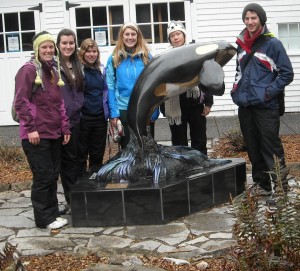
Read More
It has only been 3 days since the Gato Verde set off from the Friday Harbor Labs, but time flies when you are traveling on the water. In just this short period of time the Beam Reach class has become very familiar with the West Side of San Juan Island, especially our new home away from home, Snug Harbor. Snug Harbor is a small harbor on the West Side of the island, north of both Lime Kiln State Park and San Juan County Park (http://www.snugresort.com)
Now Snug Harbor has a comfortable familiarity, like pulling into the driveway of the home you grew up in, but upon our first arrival it was just a place to anchor for the night… And then we saw our first Snug Harbor Sunset. Although the first sunset at Snug Harbor may not have been the most spectacular of sunsets, it was special to us because it was the first of many we would experience. The West Side of San Juan Island has many magical characteristics, evergreen and deciduous forests that draw in your imagination, rocky cliffs dropping into the deep blue-green Haro Strait below, and of course the Southern Resident killer whales. All of these things I was expecting to encounter, but I never realized that I would be experiencing wondrous sunsets almost every night, and those sunsets became one of my favorite parts of cruising on the West Side of San Juan Island.
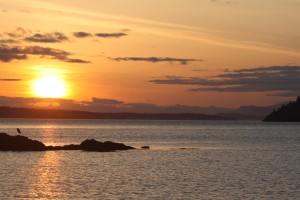
On top of the sunset Snug Harbor provides great wildlife viewing. One morning before breakfast we noticed a majestic bald eagle perched on the rock at the edge of the harbor. The skies behind him were blue and clear enough to see the mountaintops of Vancouver Island. I have seen many eagles, back in Minnesota, and on the island this spring, but this eagle was its own entity. He sat there on his perch, not even realizing the perfect photo opportunity he was giving us all. The scene looked like something off of a postcard or out of a wildlife magazine.
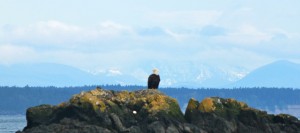
After an amazing first few days on the water and nights at Snug Harbor I look forward to the next couple of weeks. Boat life might be different and a little more difficult that life on land, but it is an adventure. Hopefully ours will include the Southern Residents soon!
Read More
I’ve always wondered how people in Medieval times sailed. I was told by the captain that it was much more difficult because they did not have motors and modern technologies such as GPS and weather forecasts. Sailors had to rely mostly on experience and observation. I find it really amazing. And I feel fortunate that we have the resources to sail safely through the oceans.
What makes the Gato Verde green? First of all, Gato Verde is the first Catamaran in the Pacific Northwest to make use of biodiesel. Gato Verde also uses LED lights on the boat, which are more energy efficient. The Gato uses lead-acid batteries, which are recyclable. These batteries only allow the Gato to go full-throttle for about 30 minutes (to be prudent). There are other types of batteries, namely nickel-metal and lithium. Lithium batteries are lighter and has twice the power of lead-acid batteries. To make the Gato more green, captain Todd has been considering adding solar panels to the boat.
On the boat, we make use of our resources sustainably. One good example is using sea water to wash dishes. It really worked for me as I usually prefer to rinse the dishes until they are spotless. I could do so without worry with sea water because we never have to worry about running out of sea water. The dishes are given a brief freshwater rinse after being thoroughly washed with sea water.
We learnt during a discussion the difference between “black water” and “grey water”. Grey water is waste water from washing. Usually, grey water from a boat is released directly into the open sea. It is worrisome to think about the potential harmful effects of surfactants on marine life. In the United States, boats are required to “pump out” their sewage at designated pump out stations. In Canada, however, boats can release their raw sewage into the open sea. This is worrisome. If sewage gets into freshwater sources, there is concern about contamination of drinking water. This is not a concern with sea water as we don’t drink sea water. However, by releasing sewage into the sea, we are releasing hormones, drug metabolites, and terrestrial pathogens into the marine environment. That can be harmful to marine life. Usually, raw sewage can be treated to remove harmful materials before being released into water.
In not so long a time we have learnt that ropes should not be called “ropes” but “lines” and “sheets” on the boat. Ropes the keep the sails in place are called “sheets”. Typically, a sailboat has a jib and mainsail. The jib is smaller than the mainsail, and its orientation is changed during tacking. Tacking is a sailing strategy where a boat sails zig-zag close reach, about 45 degrees to the direction of wind. Beam Reach is where a boat sails across the wind, approximately 90 degrees to the direction of wind. It is also good to remember the parts of the boat, especially when deploying the dock lines and fenders. The front of the boat is called “bow” and the back “stern”. On the boat, the direction to the front of the boat is “fore” and the back “aft”. With this special language, the boat seems to be a world of its own.
Read More

I once spoke to a seasoned wildlife biologist and he told me, “At least the species you are interested in are obvious and not elusive. It would be much harder to study elusive animals.”
He had a good point. At times, the day wore on without news of the whales, and even though we worked hard at taking physical oceanographic measurements, everyone grew worried that we were not going to get enough whale data. This is definitely something to keep in mind in future endeavours.
The emotions arising from “chasing whales” can sometimes get in the way. It’s frustrating, and it makes people anxious. One wonders, what can be done about it?
First of all, the team tried everytime to make the best educated guess of which spot in the Salish Sea would be the best spot to meet the whales, taking into consideration logistics such as biodiesel levels and whether there was a need to pump out or refill fresh water. Our Captain Todd had been our anchor the entire time, sharing with us his valuable knowledge and experience in seafaring. The navigation program OpenCPN gave us an edge in planning our routes.
The tides and currents played into it, too. Sometimes, the whales were sighted as far north as Point Roberts, and we had to consider the plausibility of making it to Point Roberts and back to San Juan Island for anchor in the evening.
As we did made our best effort to put ourselves in the best position, luck often played a part as well. When there is a lack of data, making a decision to chase whales that are a mile away became a dilemma. Nonetheless, despite these challenges, we had a good number of whale encounters. Some might think it too few, but in the end, the exhilaration of whale encounters, no matter how few or many there were, outweigh the frustration and as everyone got into the rhythm, everything brightened into a good day.
Read More
This has been one of the most incredible experiences of my life and has definitely changed my perspective of the world. Now I know this sounds super cheesy but it is so undeniably true. We just gave our final talks today and I never thought I would be able to so confidently talk about research to a room full of people. However, as soon as my presentation started I became so excited to share what I found with people that I was no longer nervous and really enjoyed it. If you have a strong desire to watch me talk way too fast for human hearing you can check out the recording from our talks today. With our presentations done all we have left are our final papers and then saying goodbye. I’m not sure which will be harder. I have met some amazing people on this journey and we have become a family of sorts. As I reflect on my time here I am amazed with the amount we learned but most of all the amount I changed as a person. Suddenly I’m eating vegetables like an adult, and starting to understand that I don’t know exactly what I want to do with my life. But I know that everything I learned during Beam Reach will help no matter where I go. I also know that I have made life long friends, taken part in incredible research in the Salish Sea and learned about myself along the way. So here’s to Beam Reach, for without it I would surely not be the person I am today, nor would I be headed in the direction that I am tomorrow
.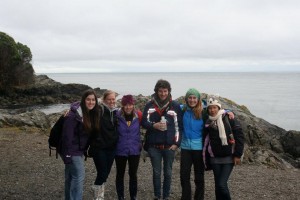
Read More
BLOG:
There is an old sailor tale that tells of a large ship one day caught in the middle of the Ocean. A large wave came over the side and knocked their anchor down into the depths of the ocean. No matter how much the sailors heaved and pulled they could not seem to pull up the anchor, and feared that if they pulled to hard they would make a hole in the bottom of the ocean, and drain out all the water. A brave sailor dove off the bow of the ship with knife in hand, ready to face whatever lay at the bottom of the sea. After a few tense minutes the sailor burst to the surface of the ocean and told the others that he had freed the anchor, and the ship was free to sail. After they had pulled him up onto the deck they asked him how he had freed the anchor. The sailor told them that a giant octopus had grabbed onto their anchor and was playing with it, but he had tied its legs into bowline knots, so it would never bother them again.
Although we didn’t encounter giant octopi on the Gato Verde (http://www.gatoverde.com/), I think this story reviles subtle truths about life out at Sea. First of all as a crew you have to be ready for anything whether it be a sea creature, or just the logistics of where to dock at night. Learning to be ready for anything at anytime takes a while to get use to, but like everything else we learned while on the Gato it seems to apply not only to sailing and science, to life.
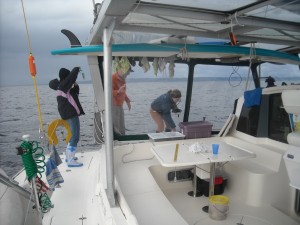
More Sailing!
One of the most important lessons I took away from the Gato was an understanding of what it takes to live sustainably. It is all too common to go through life unaware of the impact you are making, and the resources you are using. I feel that before my time on the Gato I was somewhat aware of my impact, and attempted to live sustainably, but I did not fully recognize the effect of everything I did. On the Gato we took measurements of the fresh water, sewage, and bio- diesel used. These are things that are easy to take for granted in every day life, but when living on a boat you start to realize just how much water you use, and sewage you produce. We had a water tank that held all our fresh water for dishes, drinking, and cooking with. Our water holding tank was on the port side of the Gato over the left hull. The water level was measured in cm and converted to liters and gallons. It was interesting to see how much water we used everyday. We still used a lot of water per person everyday, so it hard to imagine how much water we use daily when taking showers. The sewage tank was on the starboard side of the Gato near the bow. The sewage system was connected to the heads (bathrooms), which were on both the port and starboard side of the boat. Before the Gato I had not idea of how much sewage 8 people can produce, let alone a city, and how difficult sewage can be to deal with. Captain Todd explained the different types of holding tanks a boat can have, and the different ways to treat them. He had a type 3 system, which was an anaerobic system. He introduced a certain species of bacteria into his system that out competed the bacteria that make sewage smell. It was amazing to think that we had a tiny ecosystem on board the Gato with us. Who knew poop could be so fascinating!
In order to conserve bio-diesel we attempted to sail when the wind allowed. Although we didn’t get many opportunities to sail, it was a fun time when we did. Captain Todd taught us about the different points of sail: close-hauled, beam-reach, broad reach, running, and irons (no go zone). We got to steer the boat on our first cruse tacking down the Strait of Georgia. We learned how to sail right against the irons, without going into irons (60-50*) an ideal angle for sailing. We learned about how to let out the jib and main sail, and how to properly put both away.
As a class we also had to figure out our daily navigation. To do this we had to take a lot into consideration: the weather, sea state, tides, where the whales were, and where we would spend the night. At first this seemed to be a logistic nightmare, but after we created a routine for the navigator it became relatively easy. The hard part of navigating occurred when we had to make important decisions during the day, like if we were going to try and catch the whales.
Boat life is difficult, but extremely rewarding at the same time. Looking back my best memories of the boat involve sitting on the trampoline and just appreciating the sea that surrounded us.
Read More
 It makes everything during the day so much more exciting when there is the prospect of whales. One good thing that has come from the whales’ drawn out absence is that I have been able to re-focus my appreciation on the beauty that is San Juan Island.Today I have directed my focus to the ever-majestic Olympic Mountains. The sun is shining down on the snowy peaks that tower above the Strait of Juan de Fuca’s blue-green waters. The view in front of me is something most seen on the front of postcards, and although there may not be orca whales in my midst, I am constantly surrounded be the natural beauty of the Salish Sea and the San Juan Archipelago.
It makes everything during the day so much more exciting when there is the prospect of whales. One good thing that has come from the whales’ drawn out absence is that I have been able to re-focus my appreciation on the beauty that is San Juan Island.Today I have directed my focus to the ever-majestic Olympic Mountains. The sun is shining down on the snowy peaks that tower above the Strait of Juan de Fuca’s blue-green waters. The view in front of me is something most seen on the front of postcards, and although there may not be orca whales in my midst, I am constantly surrounded be the natural beauty of the Salish Sea and the San Juan Archipelago.


















 Twitter
Twitter LinkedIn
LinkedIn Facebook
Facebook